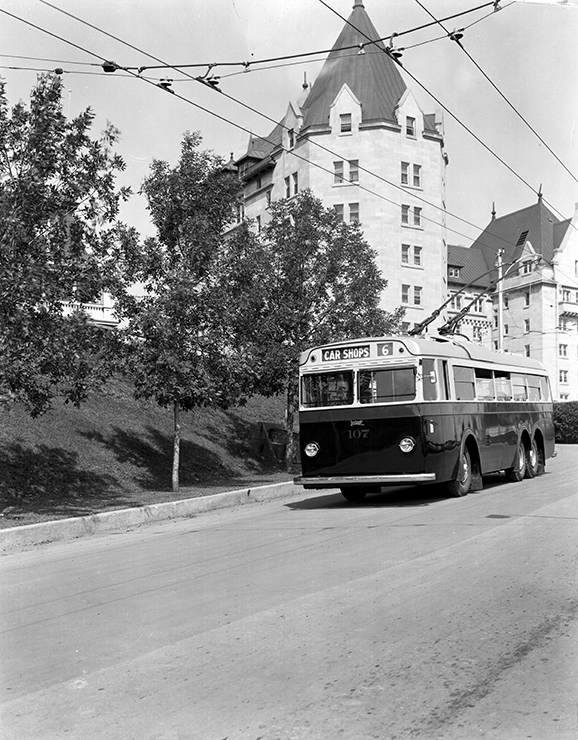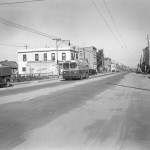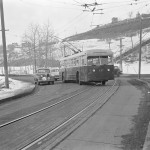For 70 years, electric trolleybuses travelled the streets of Edmonton. Between 1939 and 2009, they provided the city with an exceptionally energy-efficient and zero emission way of moving citizens around.
Back at the beginning, the trolleys were touted as a way to address mounting costs to rehabilitate the rail and running stock for the streetcar system, started in 1908. Feasibility reports presented to city council in 1938 recommended trolleys for their efficiency and safety.
In the book Edmonton’s Electric Transit, Colin Hatcher and Tom Schwarzkopf explain that the decision to launch a trolleybus service in Edmonton was made on a warm summer day in 1938. Thomas Ferrier, superintendent of the Edmonton Radial Railway and City Commissioner Robert Gibb reluctantly agreed to implement a recommendation by Toronto consultants that the street railway system be gradually replaced by “trackless trolley coaches.” The “trolley” part comes from the trolley poles on the roof of the bus used to transmit electricity from overhead wires.
Canada was just climbing out of the Great Depression and war was brewing in Europe at the time. The two men opted to go slowly, ordering six trolleys and stringing 600-volt direct current lines up and down McDougall Hill, on 95th Street between Jasper Avenue and 111th Avenue and west along Jasper to 102nd Street.
It cost $263,826 to get the system up and running, and that included the six 40-passenger trolley buses, erection of overhead electrical lines and street paving. The decision made Edmonton the third Canadian city to use the modern trolley bus, after Toronto and Montreal.The British manufacturers English Equipment Company/Associated Equipment Company and Leyland were the successful bidders, contracted to build three twin-axel trolleys apiece. Britain’s preparation for war delayed shipment of the six trolleys, pushing the arrival date from July to September. The Leyland buses were to have been loaded on the RMS Athenia, Montreal-bound from Great Britain, But there was room on the Beaverford, leaving a week earlier, and so that’s how the trolleys went.
It’s a good thing, too, because of the historical chapter yet to come. On September 4, 1939, a German submarine torpedoed the Athenia, killing six and sending 1,400 persons into the lifeboats. On September 12, 1939 the first two trolleys – named 101 and 102 – arrived in Edmonton and two more were in Montreal being unloaded. A third pair was expected to dock soon unless, as the Edmonton Bulletin wryly observed, “the boat carrying them has been torpedoed.”
Trial runs with the new trolleys commenced September 22nd on newly completed wiring downtown and along 95th Street and 115th Avenue to the bus barns on 80th Street. The public got its first chance to ride the trolleys on Sunday, September 24th. Fares were ten cents cash or five tickets for a quarter and the public response to the swift, strong and silent trolleys was very positive.
But those who rode the buses at the launch weren’t the first passengers. A story in the September 21, 1939 edition of the Edmonton Journal reported that two hoboes named Hughie and Walter had taken a ride in 103 as it was being shipped in early September from Toronto to Edmonton.
When their free ride reached its destination, they apparently were compelled to a speedy evacuation, leaving behind half a loaf of bread and a pound of bologna. They had the temerity (or perhaps the good manners) to write to Ferrier to thank him for the shelter and ask for the return of their food.
Edmontonians took to the new service in large numbers, and lobbied for improved trolley service from 99 Street and Whyte Avenue to Connors Road and 99 Street via 91 Street, then downtown via McDougall Hill. Over the next decade, more than 100 North American cities, including 14 in Canada, adopted trolley technology.
The cities were captivated by the system’s exceptional efficiency, flexibility relative to streetcars, virtually zero emissions, low maintenance cost and sophistication. Edmonton moved quickly to order more buses, and by July 1942, three more Leylands arrived.
But with Britain effectively cut off by the war, it also needed to look to American manufacturers. Three US-built Mack buses went into service in 1943 and then eight Pullman coaches arrived in the summer of 1944.
Early in 1946, two Brill-designed trolley coaches, built by American Car and Foundry of Philadelphia, arrived in Edmonton. Forty-seven Brill coaches manufactured by the Canadian Car & Foundry (CCF) in Ontario went into service in Edmonton the following year, allowing the city to expand its trolley routes.
Lines were strung along 124th Street from Jasper to 118th Avenue, along 107th Avenue, 112th Avenue east to Highlands, 118th Avenue through Alberta Avenue, down Bellamy Hill and up Walterdale Hill, along 109th Street and Whyte Avenue. With trolleys carrying more than three-quarters of the transit system’s passengers, the city’s streetcar system was retired, and the last car ran on September 1st, 1951.
The CCF Brill trolley coaches proved to be easy to maintain and durable and by 1955. Edmonton had 72 of them in service. I first rode on them as a child in the early 1960s, and remember being captivated by the way the trolley poles connected the buses to the wires with spring-loaded ropes. Occasionally the trolley would jump the wires while passing through switches along turns and the bus would roll to a halt. Then the driver would go to the back of the bus to reattach the poles, the bus would surge back to life, and we’d continue our journey.
Those Brill trolleys were the workhorses until the 1970s and were gradually replaced by the Flyers and Brown Boveri Canada (BBC) units. At its peak, the system ran 137 trolley buses over a total route length of 127 kilometers.
Edmonton’s electric trolleys survived and thrived even as oil companies and major coach manufacturers like General Motors offered attractive incentives for cities to move to diesel power. These powerful interests systematically destroyed North America’s clean electric bus systems, streetcars and trackless trolleys, replacing them with their polluting diesel buses.
The end for the city’s trolley network came in 2008 when city councillors voted seven-to-six to begin the process of dismantling it, citing concerns about increasing costs. It was a decision that remains controversial seven years later. The system was entirely shut down on May 2, 2009.
©Lawrence Herzog 2015



